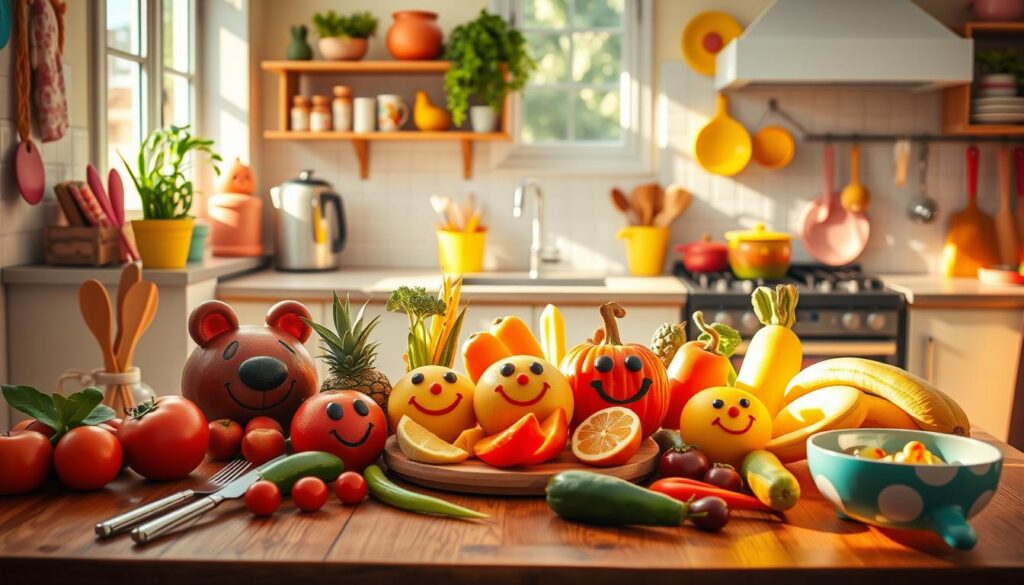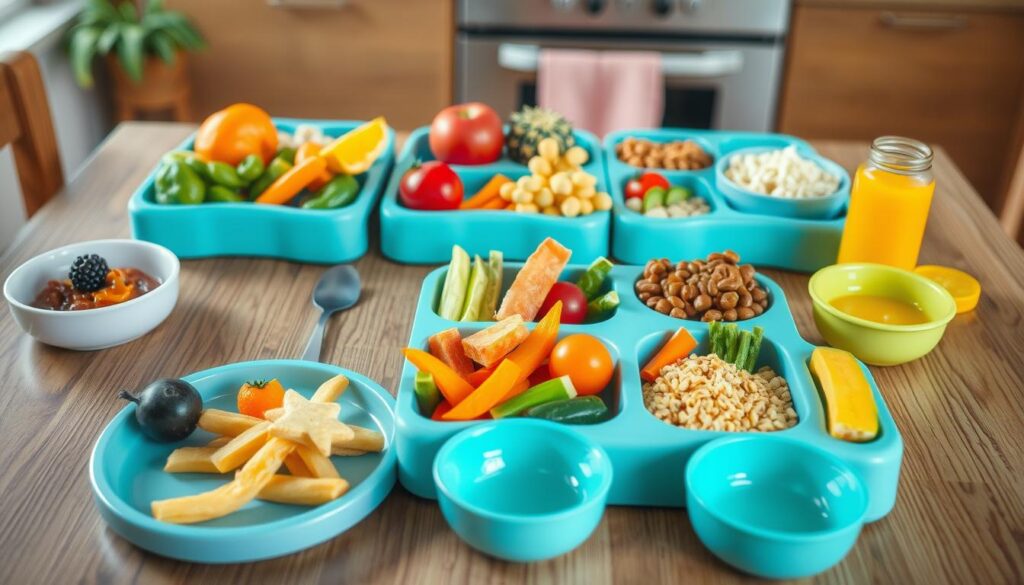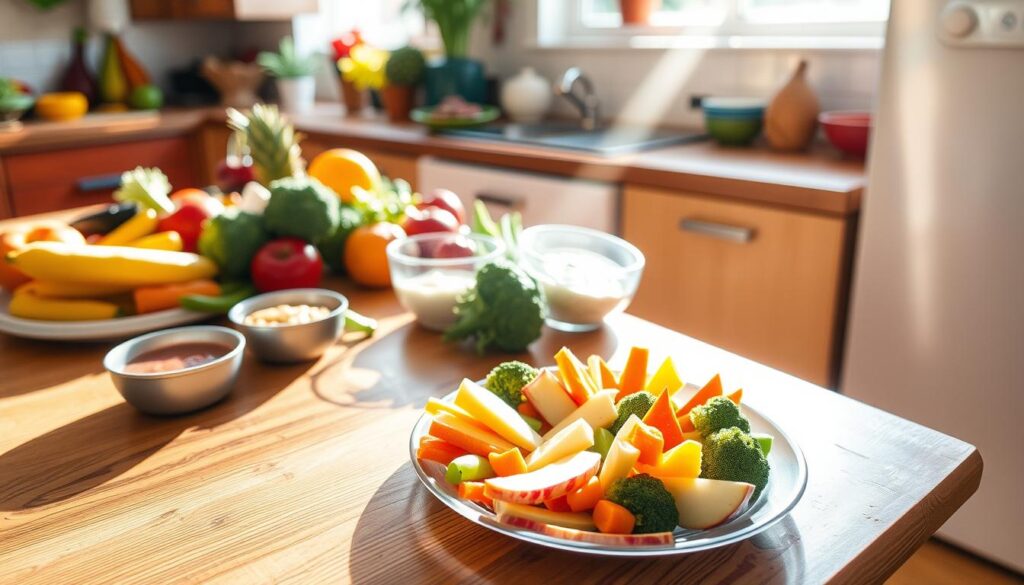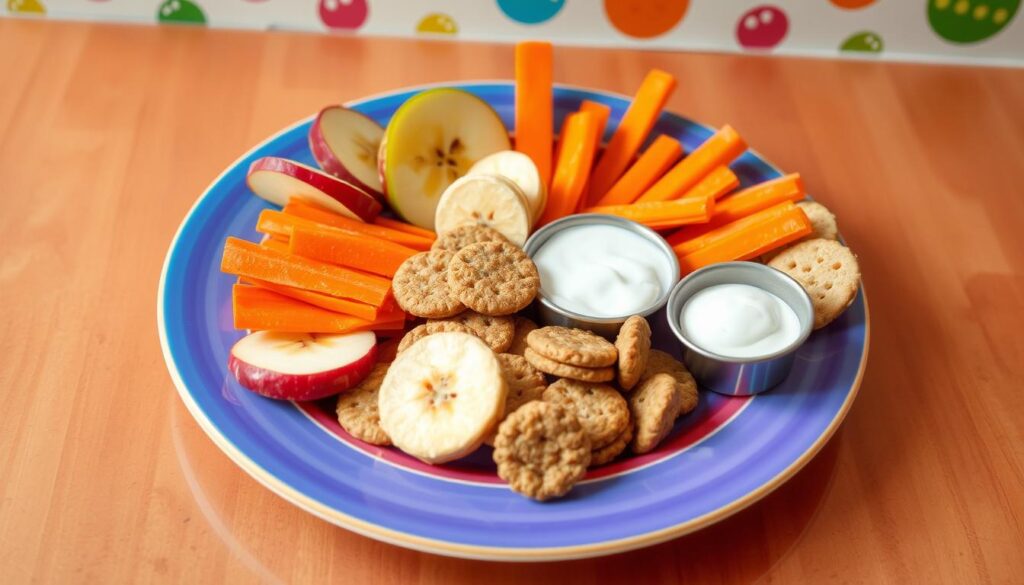As a parent, you want the best for your child, including a balanced diet. But dealing with a picky eater can be tough. You might wonder how to get them to eat veggies and other healthy foods. Learning how to build healthy eating habits in picky toddlers is key, focusing on toddler nutrition and tackling picky eaters.
It’s important to start healthy eating habits early. This can greatly impact your child’s health and well-being. By focusing on healthy eating habits in picky toddlers, you can help them develop a good relationship with food. This is vital for their nutrition and dealing with picky eaters.
Key Takeaways
- Building healthy eating habits in picky toddlers is vital for their health and well-being.
- Understanding picky eaters can help you find effective mealtime strategies.
- Learning healthy eating habits in picky toddlers can positively impact their food relationship.
- Toddler nutrition is key for their development and growth.
- Starting healthy eating habits early can benefit your child’s eating habits for life.
- By focusing on healthy eating habits in picky toddlers, you can foster a positive food relationship.
Understanding Your Toddler’s Picky Eating Behavior
Dealing with a picky toddler can be tough. But, it’s normal for kids to be picky. This behavior is part of growing up. It’s caused by food selectivity, where kids prefer certain foods.
To tackle this, knowing why kids are picky is key. It helps to understand the reasons behind their food choices.
Some reasons for picky eating include:
- Texture or taste preferences
- Lack of exposure to new foods
- Imitation of others’ eating habits
It’s normal for toddlers to be choosy. But, if they refuse food or only eat a few things, it’s a worry. Knowing why kids are picky helps parents teach them to eat well.
By understanding why kids are picky, parents can help them eat better. Next, we’ll look at how to make mealtime positive and healthy.
| Common Causes of Picky Eating | Normal vs. Concerning Eating Patterns | The Psychology Behind Food Selectivity |
|---|---|---|
| Texture or taste preferences | Selective eating | Imitation of others’ eating habits |
| Lack of exposure to new foods | Persistent refusal to eat | Genetic predisposition |
Creating a Positive Mealtime Environment
Creating a positive mealtime environment is key for healthy eating habits in toddlers. You can do this by making meals fun and nutritious. A positive setting makes your toddler excited and curious about food.
Ways to make mealtime better include turning off the TV and talking more. Make it a family event. Use colorful plates and fun utensils. Research has shown that a good mealtime atmosphere improves a child’s eating and health.
Here are some meal ideas for toddlers that make mealtime fun:
- Offer a variety of kid-friendly meals, such as pasta, chicken nuggets, and fruit salad
- Encourage self-feeding and independence during mealtime
- Make mealtime interactive by using fun and engaging utensils and plates

By making mealtime positive and serving healthy meals, you help your toddler develop good eating habits. Always keep the atmosphere positive and make mealtime special and fun for your toddler.
| Toddler Meal Ideas | Benefits |
|---|---|
| Pasta with marinara sauce | Rich in carbohydrates and fiber |
| Chicken nuggets with dipping sauce | High in protein and fun to eat |
| Fruit salad with yogurt | Rich in vitamins and minerals |
Essential Nutrients for Toddler Development
As a parent, you want your toddler to grow well. They need key nutrients for this. A balanced diet with whole foods is important for their health.
Focus on vitamins and minerals like iron, calcium, and vitamin D. These help with bones, brain, and immune health. Offer foods like lean meats, whole grains, and fruits and veggies to meet these needs.
Key Nutrients for Growth
- Protein: necessary for building and repairing tissues
- Healthy fats: support brain development and overall health
- Complex carbohydrates: provide energy for growth and development
Eating whole, nutrient-rich foods is key. Always talk to your pediatrician for specific advice. 
How to Build Healthy Eating Habits in Picky Toddlers: Expert Strategies
As a parent, you want your child to have building healthy eating habits for life. But, picky toddlers make it hard to know where to begin. Luckily, expert strategies can guide you and help your child succeed.
Start by making mealtime fun and positive. Turn it into a game or a fun activity, not a fight. Let your child help with simple tasks like washing veggies or mixing ingredients.

Also, offer a variety of foods at each meal. Include fruits, veggies, whole grains, and lean proteins. This helps your child try new things and avoid picky eating. By using these expert strategies, you can help your child develop good eating habits for the future.
- Offer a variety of foods at each meal
- Make mealtime positive and engaging
- Involve your child in the cooking process
By working together and using these expert strategies, you can help your picky toddlers develop healthy eating habits. Stay patient, consistent, and positive. Celebrate every small success.
Making Food Fun and Engaging
As a parent, you want your child to eat well. Making food fun is a great way to do this. You can make mealtime fun by cutting food into shapes or making colorful fruit salads.
Being creative and engaging is key. Use colors and shapes to make food appealing. For example, you can make a smiley face on a plate with fruits and veggies. This makes mealtime fun and encourages trying new foods.
Creative Food Presentation Ideas
- Use a cookie cutter to cut out fun shapes from bread or cheese
- Create a fruit kebab with grapes, strawberries, and pineapple
- Make a face on a plate using sliced fruits and vegetables

Interactive Meal Activities
Interactive meal activities make mealtime fun. Try games like “I Spy” with foods or taste tests. These activities make mealtime enjoyable and encourage trying new foods.
| Activity | Description |
|---|---|
| I Spy | Play a game of “I Spy” with different foods to encourage exploration |
| Taste Test | Have a “taste test” to see who can identify the most flavors |
By making food fun, you can make mealtime positive for your toddler. This encourages healthy eating and creates memories with your child.
Meal Planning for Success
Planning meals for toddlers is key to successful meal planning. It’s important to think about your child’s dietary needs and any allergies. Also, make sure to include a variety of foods in their diet. A good plan saves time, reduces waste, and ensures your child gets the nutrients they need.
Start by making a weekly meal planning calendar. List out breakfast, lunch, and dinner ideas for each day. Include healthy options like fruits, veggies, whole grains, and lean proteins. Don’t forget to add your child’s favorite foods to make toddler meal planning fun.

- Involve your child in the planning process, letting them help with meal selection and grocery shopping
- Consider batch cooking and meal prep to save time during the week
- Make sure to include a variety of foods from different food groups to ensure a balanced diet
By following these tips, you can create a successful meal planning plan. This ensures your child gets the nutrients they need to grow and develop.
| Meal | Monday | Tuesday | Wednesday |
|---|---|---|---|
| Breakfast | Oatmeal with fruit | Scrambled eggs with whole grain toast | Yogurt parfait with granola and berries |
| Lunch | Grilled chicken with mixed vegetables | Turkey and cheese wrap with carrot sticks | Chicken quesadilla with mixed greens salad |
| Dinner | Baked salmon with roasted sweet potatoes and green beans | Chicken and vegetable stir-fry with brown rice | Beef and broccoli pasta with whole grain bread |
Introducing New Foods Successfully
Introducing new foods to your toddler can be tough. You want them to get the nutrients they need. The three-time rule is a good way to start. It means trying a new food three times before deciding if they like it.
Food bridging techniques are also helpful. This means introducing foods similar to ones they already like. For example, if they love apples, try pears or other fruits. This makes trying new foods less scary and more fun.
It’s important to handle food rejection well. Stay calm and don’t force them to eat. Make mealtime fun with creative food and interactive activities. Here are some tips:
- Offer a variety of foods at each meal for a balanced diet
- Use colorful plates and utensils to make mealtime fun
- Involve your child in cooking to make them more interested in the meal

By using these tips, your child will learn to enjoy trying new foods. Stay patient and positive. With time, they’ll become more confident and mealtime will be more enjoyable for everyone.
| Food | Similar Foods | Introduction Tips |
|---|---|---|
| Apples | Pears, bananas | Try cutting into fun shapes or serving with peanut butter |
| Carrots | Broccoli, sweet potatoes | Steam or roast to bring out natural sweetness |
| Chicken | Turkey, fish | Try serving in a variety of sauces or seasonings |
Smart Snacking Guidelines
As a parent, you want your toddler to get the nutrients they need to grow. Smart snacking is key to a healthy diet. It’s important to pick snacks that fuel your child’s body. Finding the right timing between meals is also vital to avoid over-snacking.
Healthy snack options include fruits, veggies, and whole grain crackers. You can also make your own snacks, like trail mix or energy balls. Remember to always check the ingredient labels to avoid added sugars, salt, and unhealthy fats.

- Offer snacks in between meals to keep your child’s energy levels up
- Choose snacks that are rich in nutrients, such as fruits and vegetables
- Avoid giving your child snacks that are high in added sugars, salt, and unhealthy fats
By following these guidelines, you can help your child develop good eating habits. Timing between meals is also key. It helps prevent over-snacking and ensures your child gets the right nutrients at the right times.
Common Mistakes to Avoid
When teaching your toddler about healthy eating, it’s key to know common mistakes. Avoiding mistakes like forcing them to eat or using food as rewards is important. This helps build a good relationship with food. Being aware of these mistakes helps create a supportive environment for healthy eating.
Some common mistakes to watch out for include:
- Being too restrictive with food choices, which can lead to feelings of deprivation and rebellion
- Not involving your child in the meal planning and preparation process, which can make them less invested in trying new foods
- Using screen time or other distractions during meals, which can make mealtime less engaging and enjoyable
By avoiding these common mistakes, you can help your child develop healthy eating habits that will last a lifetime. Stay patient, consistent, and positive. Always keep the conversation about food open and supportive. Avoiding mistakes and focusing on healthy eating habits will help you raise a happy and healthy eater.
Remember, establishing healthy eating habits in your toddler is a journey. It’s okay to make mistakes along the way. The key is to learn from those mistakes and use them as opportunities to grow and improve. By doing so, you’ll be well on your way to raising a child who has a positive and healthy relationship with food, and who will make healthy eating habits a priority for years to come.
Building Long-term Healthy Relationships with Food
As you help your toddler learn to eat well, focus on building healthy relationships with food. Make mealtime a positive place and be a good role model. This helps your child see food’s value and how it affects their health.
Being a good role model means eating a variety of foods and trying new things. Show thanks for the food you have. Your child will likely follow your example. Also, make family meal importance a key part of your life. Sharing meals helps you bond and teaches your child about food.
- Encourage them to try new foods and flavors.
- Make mealtime a positive and calm place.
- Show them healthy eating by being a good role model.
- Make family meal importance a big deal and eat together.
By following these tips and staying consistent, you can help your child love food. This sets them up for a lifetime of healthy eating and well-being.
Conclusion: Nurturing Your Toddler’s Journey to Healthy Eating
Starting your toddler on the path to healthy eating is a journey. It needs patience, consistency, and a positive attitude. Every small step, like trying a new veggie or finishing their meal, shows your hard work and your child’s growing interest in good food.
Your toddler’s taste in food will change often. With your help, they’ll discover many flavors and textures. By showing them good eating habits, letting them help in the kitchen, and making meals fun, you’re teaching them to love healthy eating for life.
Always celebrate your toddler’s small wins. Encourage their curiosity, thank them for trying new foods, and be patient when they’re slow to adapt. With your support, your toddler will grow to love healthy eating, benefiting their body and mind for many years.
